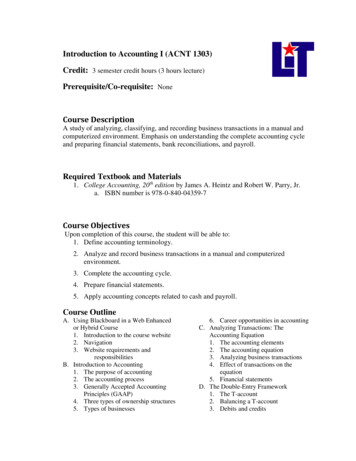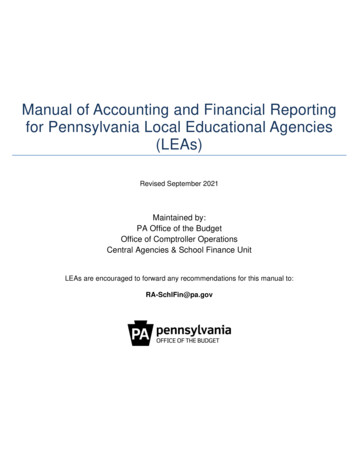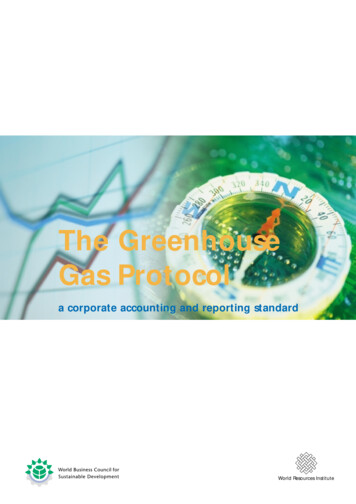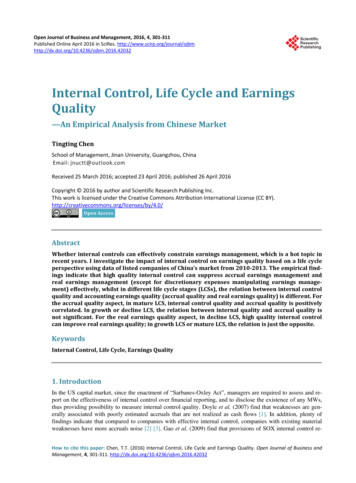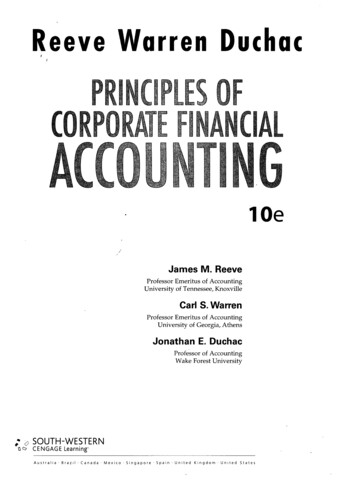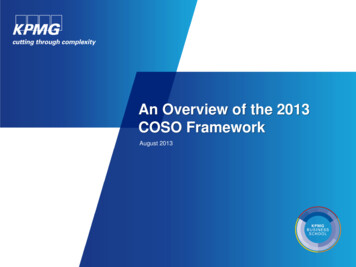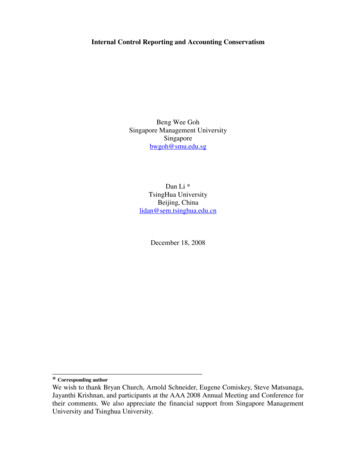
Transcription
Internal Control Reporting and Accounting ConservatismBeng Wee GohSingapore Management UniversitySingaporebwgoh@smu.edu.sgDan Li *TsingHua UniversityBeijing, Chinalidan@sem.tsinghua.edu.cnDecember 18, 2008* Corresponding authorWe wish to thank Bryan Church, Arnold Schneider, Eugene Comiskey, Steve Matsunaga,Jayanthi Krishnan, and participants at the AAA 2008 Annual Meeting and Conference fortheir comments. We also appreciate the financial support from Singapore ManagementUniversity and Tsinghua University.
Internal Control Reporting and Accounting ConservatismAbstractOne objective of the internal control reporting requirements of the Sarbanes-Oxley Act of2002 (SOX) is to improve the quality of financial reporting. This study examines whethera relation exists between internal control quality and accounting conservatism, which isan important feature of high financial reporting quality. Using a sample of firms whichdisclose material weaknesses (MWs) in internal control under SOX, we find that firmswith MWs exhibit less accounting conservatism than firms with no such weaknesses.However, firms that disclose MWs and whose auditors subsequently confirm theremediation of these weaknesses exhibit more conservative accounting earnings thanfirms that continue to have MWs. We also find that the internal control reportingrequirements have a disciplining effect on firms’ financial reporting. Specifically, firmswith MWs exhibit more conservative earnings after the disclosure of such weaknesses,regardless of whether or not these weaknesses are remediated. Overall, our results showthat the quality of internal control affects accounting conservatism and underscore theimportance of the internal control reporting requirements in enhancing the quality offinancial reporting.Key words: internal control; conservatism; material weaknesses; disclosure; SarbanesOxley Act1
1.Introduction“This law (Sarbanes-Oxley Act) says to shareholders that the financial information youreceive from a company will be true and reliable. This law says to workers: we will nottolerate reckless practices that artificially drive up stock prices and eventually destroy thecompanies, and the pensions, and your jobs.”1President George W BushIn 2002, following a series of high-profile cases of corporate improprieties, theU.S. Congress passed the Sarbanes-Oxley Act (SOX), which is widely considered tocontain the most important and sweeping corporate reforms since the 1930s. As can beseen from the above excerpt from President Bush’s speech, made during his signing ofthe Act, one of the objectives of regulators in passing SOX is to ensure the reliability offinancial reporting and to prevent companies from artificially driving up stock prices tomislead investors. 2 In this study, we examine whether the internal control reportingrequirements of SOX help to enhance the quality of financial reporting by ensuringconservative accounting practices.31This speech of President Bush can be found /20020730.html.2Underlying the internal control reporting requirements is the regulators’ concern that weak internalcontrols undermine financial reporting quality and result in a company’s use of aggressive accounting rulesto create artificially high stock prices. Indeed, anecdotal evidence suggests that weak internal controls arerelated to fraudulent financial reporting. In 1999, a study conducted by the Committee of SponsoringOrganizations of the Treadway Commission (COSO) asserted that a poor internal control environmentcontributed to the occurrences of fraud documented over the ten year time frame 1987-1997. The formerSEC Commissioner, Isaac Hunt Jr., in his speech in 1999, also noted that “internal control deficiencies wereundermining the financial reporting system.” (Hunt 1999).3Two important SOX provisions to achieve this objective are Sections 302 (SOX 302) and 404 (SOX 404)of the Act. SOX 302 requires management to evaluate the effectiveness of disclosure and controlprocedures, report results of the evaluation, and indicate any “significant changes” in internal controls sincethe last Form 10-K or Form 10-Q was filed (SEC 2002). SOX 404 requires the management’s assessmentof internal controls over financial reporting and the auditors’ report on the effectiveness of internal controlsto be included in the firms’ 10-K reports (SEC 2003).2
Unlike Doyle et al. (2007a) and Ashbaugh-Skaife et al. (2008a), which examinethe relation between internal control quality and accruals quality, we choose accountingconservatism as our measure of financial reporting quality. This is because Watts (2003a,2003b) argues that conservative accounting benefits the users of a firm’s accountingreports, by preventing managers from introducing bias and noise into contractualaccounting measures in order to overpay themselves. Also, conservative accountingresults in the early termination of negative NPV (Net Present Value) investments andmitigates the incentives of managers, in reporting accounting measures used in a contract,to undertake negative NPV project behavior. Therefore, the interests of stakeholders arebetter protected when managers practice conservative accounting than when they do not.In sum, accounting conservatism is an important feature of high quality financialreporting.We first examine whether weak internal controls are associated with lessconservative accounting. If such a relation exists, then the regulators’ emphasis oninternal controls to prevent companies from using overly aggressive accounting practicesis justified and would benefit stockholders. In addition, in order to allow strongerinferences to be made about the effects of internal control weaknesses (ICWs) onaccounting conservatism, we conduct inter-temporal tests of the changes in the status ofinternal controls. We specifically examine whether firms that disclose, and laterremediate, ICWs show greater accounting conservatism than firms that continue to havesuch weaknesses. Lastly, as Watts (2003a) contends that a demand for accountingconservatism arises from litigation, we expect the disclosure of ICWs under SOX topotentially increase the litigation risks of these firms (i.e., as a result of their overlyaggressive accounting practices or less conservative accounting). Hence, we also examine3
whether firms with ICWs report more conservatively after the disclosure of theseweaknesses. Such conservative reporting behavior will provide evidence that thereporting requirements have a disciplining effect on firms to report conservatively andwill mitigate investors’ concerns that earnings and net assets are overstated.Following Basu (1997) and Watts (2003a, 2003b), we define conservatism as theapplication of a higher standard of verification for favorable information, wherebyaccounting income reflects “bad news” on a more timely basis than “good news.” Weoperationalize accounting conservatism in a number of ways. Two tests of conditionalconservatism, based on Basu, are widely applied in empirical accounting research. First,we use a piecewise linear regression of earnings on contemporaneous stock returns toexamine whether weak internal controls are associated with lower timeliness to reflectbad news. Second, we examine whether weak internal controls are negatively associatedwith the rate of the reversal of negative earnings changes. Finally, to overcome thepotential limitations associated with the interpretations and assumptions underlying theapproaches of Basu, we conduct additional tests of conditional conservatism as suggestedby Ball and Shivakumar (2005, 2006), namely accrual-based conditional conservatism.Using a sample of firms which disclosed at least one material weakness (MW)from January 2003 to November 2005, we find results that are generally consistent withour expectations.4 First, we find that firms with weak internal controls, as proxied by theexistence of at least one MW, exhibit lower levels of accounting conservatism comparedto control firms without such weaknesses. This result is in line with the expectation of4According to Auditing Standards No. 2 (PCAOB 2004), a MW is “a significant deficiency, or combinationof significant deficiencies, that results in more than a remote likelihood that a material misstatement of thefinancial statements will not be prevented or detected.” A significant deficiency is “a control deficiency, orcombination of control deficiencies, that adversely affects the company’s ability to initiate, authorize,record, process, or report external financial data reliably in accordance with generally accepted accountingprinciples such that there is more than a remote likelihood that a misstatement of the company’s annual orinterim financial statements that is more than inconsequential will not be prevented or detected.”4
regulators that weak internal controls result in a lower quality of financial reporting.Second, we find that firms that disclose and later remediate their MWs exhibit greateraccounting conservatism than firms that continue to have these weaknesses. This findingsuggests that the improvement in internal control quality results in more conservativeaccounting; this further strengthens the results on the relation between internal controlquality and accounting conservatism. Finally, we find that our sample of firms with MWsreport more conservatively after the disclosure of these weaknesses, regardless ofwhether or not these weaknesses are remediated. This result suggests that the internalcontrol reporting requirements have a disciplining effect on firms with weak internalcontrols, possibly because of the increasing litigation risk following the disclosure ofMWs. Overall, our results provide empirical evidence that supports the benefits of theinternal control reporting requirements of SOX against the widely documented costs ofthese requirements (SEC 2006).This study makes several contributions. First, it examines the implications of theinternal control reporting requirements of SOX on the financial reporting quality of firms.This issue is timely and important given the controversies surrounding the internalcontrol reporting requirements of SOX, such as the high costs of compliance. Given thataccounting conservatism is universally demanded by stakeholders (Ball et al. 2000; Basuet al. 2001) and is an important feature of high quality financial reporting, examining theassociation between internal control quality and accounting conservatism can provideinsights into the efficacy of the internal control reporting requirements. With regard tofinancial reporting, our results show that mandating firms to assess their internal controlsand to disclose the ICWs discovered in the process can have a disciplining effect on firmsto report more conservatively. The remediation of previously identified ICWs also makes5
firms more conservative in their financial reporting. Hence, the internal control reportingrequirements of SOX provide benefits to market participants by ensuring that financialreporting is both more conservative and of a higher quality.Second, prior research finds that conditional conservatism, as measured byasymmetric timeliness, varies across the characteristics and economic contexts of firms(Basu et al. 2001; Ball et al. 2000, 2003; Beekes et al. 2004; Ball and Shivakumar 2005;Bushman and Piotroski 2006; Ahmed and Duellman 2007). This study extends this lineof research by suggesting that internal control quality is a potential factor that drives theobserved differences in conservatism between public companies. Specifically, higherinternal control quality could lead to a higher level of conservative reporting. Also, weshow that firms report more conservatively after the disclosure of MWs, which isconsistent with the argument of Watts (2003a) that a demand for accounting conservatismarises from litigation.Third, prior research finds that firms with ICWs present higher information risk toinvestors relative to firms having effective internal controls, resulting in higher cost ofequity (Ashbaugh-Skaife et al. 2008b). Hence, firms with ICWs potentially increaseagency costs between management and outsiders. Watts (2003a, b) argues thataccounting conservatism has evolved as part of an efficient contracting technology thathelps in reducing deadweight losses resulting from agency problems. Our findings thatstrong internal controls are associated with higher accounting conservatism provideadditional evidence on the efficacy of conservatism in reducing potential agency costs offirms.Finally, this study complements related studies examining the relation betweeninternal control and financial reporting quality. Doyle et al. (2007a) and Ashbaugh-Skaife6
et al. (2008a) find that internal control quality is positively related to earnings quality, asmeasured by the extent to which accruals are realized as cash flows. This study finds thatinternal control quality is positively related to accounting conservatism, which is anotherimportant element of earnings quality.The remainder of the paper is organized as follows: Section 2 develops thehypotheses; Section 3 explains the research design; Section 4 presents the empiricalresults; Section 5 describes additional analyses; and Section 6 concludes.2.Hypothesis developmentFama and Jensen (1983) contend that the modern large corporation ischaracterized by the absence of the classical entrepreneurial decision maker. Instead, thecompany’s residual claims are diffused among many shareholders, who vest theirdecision rights in the company’s managers. Agency costs are created because themanagers who initiate and implement important decisions do not bear a major share ofthe wealth effects of their decisions. To mitigate agency problems, shareholders alignmanagerial incentives by linking managerial compensation to firm performance. This, inturn, incentivizes managers to overstate firm performance in the short term, in order toextract greater compensation for themselves. Once managers make excessivedistributions to themselves, it is extremely difficult to recover these distributions,especially once the managers retire or leave the firm. Watts (2003a) points out that thiseffectively implies a limited liability of managers with respect to shareholders.Watts (2003a) also argues that such moral hazard problems will exist in financialreporting as long as the reports’ accounting measures inform investors about managerialperformance and will affect the asset allocation decisions of investors and the welfare ofmanagers. These effects on their welfare will motivate managers to introduce bias and7
noise into the same accounting measures that regulators hope will inform investors, justas they motivate managers to introduce bias and noise into contractual accountingmeasures. The absence of constraints on this opportunistic managerial behavior meansthat the accounting measures in financial reports that, a priori, appear neutral will, inpractice, be significantly biased and noisy.Watts (2003a) argues that conservative accounting is a means of addressing themoral hazard caused by the parties to a firm having asymmetric information, asymmetricpayoffs, limited horizons, and limited liability. For example, conservatism can constrainthe management's opportunistic behavior in reporting the accounting measures used in acontract. In practice, conservatism more than offsets managerial bias, and, on average,also defers earnings and understates cumulative earnings and net assets. In contracts theseeffects increase a firm’s value because they constrain the management’s opportunisticpayments to themselves and to other parties, such as the shareholders. This increasedvalue is shared among all parties to the firm, increasing everyone's welfare. In this sense,conservatism is an efficient contracting mechanism.Despite the importance of conservative accounting in promoting efficientcontracting between managers and shareholders, little is understood about themechanisms that can facilitate conservative accounting. The importance of internalcontrols, such as a monitoring mechanism, has long been highlighted by researchers. TheSEC (Securities and Exchange Commission) defines internal control as “a process,effected by an entity’s board of directors, management and other personnel, designed toprovide reasonable assurance regarding the reliability of financial reporting.” Hence,effective internal controls can facilitate conservative accounting by preventing8
management from introducing bias and noise into accounting measures and by requiringstricter standards in recognizing good news as gains rather than bad news as losses.For instance, an important internal control over financial reporting is themaintenance of proper accounting policies and procedures and of adequate controls overnon-routine transactions. When proper accounting policies and procedures are absent orinadequate, management is more likely to introduce bias and noise into accountingmeasures, in order to expedite the recognition of revenues/gains and to defer therecognition of expenses/losses. On the other hand, when accounting policies andprocedures are clearly stipulated, management has less room to use aggressive accountingpractices to increase their compensation.Another important internal control that can facilitate conservative accounting isthe existence of an effective internal audit function. A firm’s manager frequently hasmore information than the shareholders on matters such as the future cash flows fromnew product development. In the absence of a verification requirement, a manager canbias upward the estimates of those future cash flows, producing large payments underearnings-based compensation plans and possibly leading to negative NPV investments bythe firm. The recovery of excess compensation payments and reparations for excessinvestments is difficult when a manager leaves the firm before the cash flows are realized.An effective internal audit function can independently verify the estimates of future cashflows and report their estimates independently to the board for ratification. This mayallow the identification of negative NPV investments, and prevent the short-term horizonproblems that arise when the management forgoes positive NPV projects with near-termnegative earnings. Overall, the presence of an effective internal audit function facilitatesthe use of conservative accounting.9
Finally, an important internal control is the hiring of accounting personnel withboth high levels of accounting expertise and technical competence in either financialaccounting standards or SEC filing requirements. Many aggressive and fraudulentaccounting practices have involved the use of complex and highly structured accountingtransactions; the Enron case is a good example of such practices. Without sufficientexpertise and technical competence among the accounting personnel, the managementhas greater opportunities to structure complex transactions in order to overstate earningsand net assets. Furthermore, such aggressive accounting practices may be likely to goundetected if the accounting personnel are incompetent. Therefore, ensuring an adequatestaffing of highly competent and/or experienced accounting personnel can furtherfacilitate conservative accounting.Given the above discussions, we hypothesize a positive relation between internalcontrol quality and the level of accounting conservatism: firms with ICWs are likely toexhibit less accounting conservatism than firms with no such weaknesses. Also, toascertain further the relationship between internal control quality and accountingconservatism, we perform inter-temporal tests, as in Ashbaugh-Skaife et al. (2008a), toexamine whether firms with ICWs that show an improvement in internal control qualityexhibit more accounting conservatism than firms that fail to show a similar improvement.A significant result would not only show that the remediation of ICWs can cause firms toreport more conservatively, but would also strengthen the results on the positiveassociation between internal control quality and accounting conservatism. Hence, wehypothesize as follows:H1: There is a positive relation between internal control quality and the levelof accounting conservatism.10
H2: Firms with ICWs that remediate previously disclosed weaknesses exhibitgreater accounting conservatism than firms that continue to have such weaknesses.If, a priori, firms with lower internal control quality are less conservative in theiraccounting practices, and the objective of SOX is to prevent overly aggressive accountingpractices, then an important issue is whether the internal control reporting requirementsof SOX increase the level of accounting conservatism for firms with low internal controlquality. To shed light on this issue, we examine whether these firms with lower internalcontrol quality report more conservatively after the disclosure of ICWs. Based on Watts(2003a), we argue that there are two reasons to explain why these firms report moreconservatively after the disclosure of ICWs.Firstly, Watts (2003a) contends that litigation is one reason for firms to engage inconservative accounting, as litigation is more likely when earnings and net assets areoverstated rather than understated. The disclosure of ICWs is likely to increase the risk ofthe firm being sued because investors become aware of its lower internal control qualityand may perceive this as resulting in the overstatement of earnings and net assets.Consequently, a firm has incentives to employ more conservative accounting practicesafter it reports ICWs, so as to mitigate its risk of being sued. Secondly, Watts (2003a)contends that regulation provides incentives for the reported financial statements of firmsto be conservative, as losses from overvalued assets and overstated income are moreobservable and usable in the political process than forgone gains due to undervaluedassets or unvalued income. This phenomenon creates incentives for regulators andstandard setters to be conservative.The passing of SOX can be seen as an attempt and a prompt maneuver byregulators to stem overly aggressive accounting and to restore investor confidence infinancial reporting. As weak internal controls are more likely to result in overly11
aggressive accounting, the internal control reporting requirements can be seen as part ofthe regulators’ efforts to ensure effective internal controls and financial reporting quality.Any reporting of ICWs is likely to be subject to increased scrutiny by the regulatorsbecause these firms have the greatest likelihood of aggressive accounting practices. Thisintensifies the pressure on a firm to report more conservatively, in order to reduce thepolitical costs. Based on the above discussions, we expect a firm to report moreconservatively after the disclosure of ICWs.H3: For firms with ICWs, accounting conservatism is higher after thedisclosure of these weaknesses than before the disclosure.3.Research Design3.1Measures of accounting conservatism3.1.1Timeliness of earnings to “news”Our first measure of accounting conservatism is a firm’s timeliness of earnings tonews. Asymmetric recognition of economic losses indicates that earnings reflect “badnews” more quickly than “good news.” In a piecewise-linear regression, with marketadjusted stock return as the independent variable and current-year accounting income asthe dependent variable, as shown in model (1) below, the timeliness of earnings isinferred from the responsiveness of accounting income to the change in market values.Negative and positive market-adjusted stock returns are used, respectively, as proxies forbad news and good news.NI 0 1DR 2R 3R*DR (1)where firm i and time t subscripts are omitted. NI is the net income, before extraordinaryitems reported, for firm i in the period t divided by the beginning of fiscal year totalassets, DR is an indicator variable that equals 1 if the market-adjusted return for firm i12
during year t is negative, and 0 otherwise, and R is the market-adjusted annual stockreturn for firm i at the fiscal year-end.The asymmetric recognition of economic losses relative to gains (i.e., conditionalconservatism) is captured by the coefficient3.To examine H1, we include the additionalintercept and interactive slope coefficients to capture the incremental effect of theexistence of MWs (i.e., firms with low internal control quality) on conservatism, asshown in model (2). A negative coefficient for7will indicate that firms with MWs havelower incremental timeliness of earnings to bad news than firms without such weaknesses;this result will be consistent with H1.NI 1DR 2R 7R*DR*MW 03R*DR 4MW 5DR*MW 6R*MW(2)where firm i and time t subscripts are omitted. MW is an indicator variable that equals 1if the firm has MWs in internal controls, and 0 otherwise. The other variables are aspreviously defined.The hypothesis H2 predicts that MW firms that remediate these weaknesses willreport more conservatively than firms that continue to have these weaknesses. Toexamine this hypothesis, we include MW FIXED in model (1), as shown in model (3),where MW FIXED is an indicator variable that equals 1 if the firm has remediated MWsat the time of the second SOX 404 report, and 0 otherwise. Ashbaugh-Skaife et al. (2008a)determine whether a firm remediates its ICWs on the basis of the receipt of a subsequentunqualified SOX 404 opinion. As an unqualified SOX 404 opinion objectively andunambiguously shows that the firm has fully remediated its MWs, we use the SOX 404opinions to determine the timeliness of firms in the remediation of such weaknesses. Wedeem a firm to have remediated MWs if it receives an unqualified second SOX 40413
report, and to have continuing MWs if it receives an adverse second SOX 404 report. Apositive coefficient of7 wouldsuggest that firms that remediate ICWs exhibit moreaccounting conservatism that firms that do not, further strengthening the proposition of apositive relation between internal control quality and accounting conservatism.NI 1DR 2R 3R*DR 4MW FIXED R*MW FIXED 7R* DR*MW FIXED 605DR*MW FIXED(3) where firm i and time t subscripts are omitted .To examine H3, we include an indicator variable EXPOST in model (1), as shownin model (4), where EXPOST is coded as 1 for fiscal years after the disclosure of MWs(i.e., the fiscal years 2003 to 2005, 2004 and 2005, and 2005, respectively, for firms thatdisclose MWs in 2003, 2004, and 2005). If, as predicted by H3, the higher litigation riskassociated with the disclosure of MWs causes these firms to report more conservatively,the coefficient7 isNI expected to be significantly positive.0 1DR 6R*EXPOST2R 3R*DR 4EXPOST 7R*DR*EXPOST 5DR*EXPOST(4)where firm i and time t subscripts are omitted. EXPOST is an indicator variable thatequals 1 for the fiscal years after the disclosure of MWs, and 0 for the fiscal years beforethe disclosure of MWs. The other variables are as previously defined.3.1.2Persistence of earnings changesAlthough empirical research has widely used the approach of Basu (1997) fortests of conditional conservatism (e.g., the asymmetric recognition of losses), both theapplication and interpretation of model (1) require caution. Gigler and Hemmer (2001)develop a model of the relation between the biases in financial reporting and themanagers’ incentives to issue timely voluntary disclosures. They find that firms withrelatively more conservative accounting are less likely to make timely voluntary14
.Consequently,contemporaneous stock returns reflect the news more quickly for firms with lessconservative accounting.5Being mindful of these issues, we use a second approach based on another test ofconditional conservatism in Basu, namely the lower persistence of negative earningschanges. Basu shows that, relative to good news periods, conservatism results in lowerpersistence of earnings in bad news periods. Higher persistence means that less currentvalue relevant news is reported in current earnings and that more of it will be reported infuture earnings. The deferred recognition of relatively good news results in positivechanges in income being less likely to reverse than negative earnings changes. This isbecause, from a time series perspective, the bad news reflected in current earnings willappear as a transitory shock in the earnings process, whereas the effects of a currentpositive shock will be spread over the earnings of several future periods as anticipatedgains are realized. The following model from Basu is used to estimate this relation:NIt 0 1DNIt-1 where firm i subscripts are omitted.2NIt-1 3DNIt-1* NIt-1 (5)NIt is the change in net income, before extraordinaryitems, for firm i in fiscal year t deflated by beginning-of-year total assets,NIt-1 is thechange in net income for firm i in fiscal year t-1 deflated by beginning-of-year totalassets, and D NIt-1 is an indicator variable that equals 1 if NIt-1 0, and 0 otherwise.Timely recognition of economic losses implies that these losses are recognized astransitory income decreases, and are therefore reversed in the next period, leading to a5Dietrich et al. (2007) argue that the interpretation of model (1) is valid only when the market is efficient; in particular,if market returns cause earnings, and not the reverse. However, Ryan (2006) notes that two well-known empiricalresults, the low R2s observed in contemporaneous returns-earnings regressions (Collins et al. 1997; Ely and Waymire1999; Francis and Schipper 1999) and a large literature showing that returns typically reflect information on a timelierbasis than earnings, indicate that the concern mentioned by Dietrich et al. is likely to induce a very tiny bias in theestimation of conservatism.15
negative value of3.The less negative the coe
Internal Control Reporting and Accounting Conservatism Beng Wee Goh . One objective of the internal control reporting requirements of the Sarbanes-Oxley Act of 2002 (SOX) is to improve the quality of financial reporting. . measured by the extent to which accruals are realized as cash flows. This study finds that internal control quality is .



